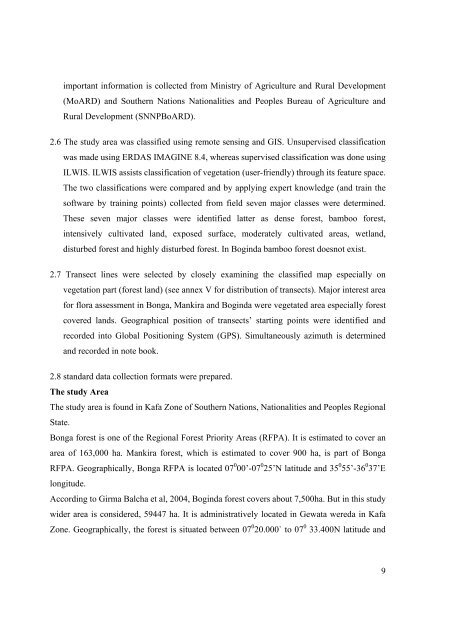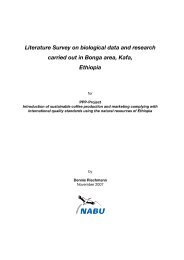Flora Biodiversity Assessment in Bonga, Boginda and Mankira Forest
Flora Biodiversity Assessment in Bonga, Boginda and Mankira Forest
Flora Biodiversity Assessment in Bonga, Boginda and Mankira Forest
Create successful ePaper yourself
Turn your PDF publications into a flip-book with our unique Google optimized e-Paper software.
important <strong>in</strong>formation is collected from M<strong>in</strong>istry of Agriculture <strong>and</strong> Rural Development<br />
(MoARD) <strong>and</strong> Southern Nations Nationalities <strong>and</strong> Peoples Bureau of Agriculture <strong>and</strong><br />
Rural Development (SNNPBoARD).<br />
2.6 The study area was classified us<strong>in</strong>g remote sens<strong>in</strong>g <strong>and</strong> GIS. Unsupervised classification<br />
was made us<strong>in</strong>g ERDAS IMAGINE 8.4, whereas supervised classification was done us<strong>in</strong>g<br />
ILWIS. ILWIS assists classification of vegetation (user-friendly) through its feature space.<br />
The two classifications were compared <strong>and</strong> by apply<strong>in</strong>g expert knowledge (<strong>and</strong> tra<strong>in</strong> the<br />
software by tra<strong>in</strong><strong>in</strong>g po<strong>in</strong>ts) collected from field seven major classes were determ<strong>in</strong>ed.<br />
These seven major classes were identified latter as dense forest, bamboo forest,<br />
<strong>in</strong>tensively cultivated l<strong>and</strong>, exposed surface, moderately cultivated areas, wetl<strong>and</strong>,<br />
disturbed forest <strong>and</strong> highly disturbed forest. In Bog<strong>in</strong>da bamboo forest doesnot exist.<br />
2.7 Transect l<strong>in</strong>es were selected by closely exam<strong>in</strong><strong>in</strong>g the classified map especially on<br />
vegetation part (forest l<strong>and</strong>) (see annex V for distribution of transects). Major <strong>in</strong>terest area<br />
for flora assessment <strong>in</strong> <strong>Bonga</strong>, <strong>Mankira</strong> <strong>and</strong> Bog<strong>in</strong>da were vegetated area especially forest<br />
covered l<strong>and</strong>s. Geographical position of transects’ start<strong>in</strong>g po<strong>in</strong>ts were identified <strong>and</strong><br />
recorded <strong>in</strong>to Global Position<strong>in</strong>g System (GPS). Simultaneously azimuth is determ<strong>in</strong>ed<br />
<strong>and</strong> recorded <strong>in</strong> note book.<br />
2.8 st<strong>and</strong>ard data collection formats were prepared.<br />
The study Area<br />
The study area is found <strong>in</strong> Kafa Zone of Southern Nations, Nationalities <strong>and</strong> Peoples Regional<br />
State.<br />
<strong>Bonga</strong> forest is one of the Regional <strong>Forest</strong> Priority Areas (RFPA). It is estimated to cover an<br />
area of 163,000 ha. <strong>Mankira</strong> forest, which is estimated to cover 900 ha, is part of <strong>Bonga</strong><br />
RFPA. Geographically, <strong>Bonga</strong> RFPA is located 07 0 00’-07 0 25’N latitude <strong>and</strong> 35 0 55’-36 0 37’E<br />
longitude.<br />
Accord<strong>in</strong>g to Girma Balcha et al, 2004, Bog<strong>in</strong>da forest covers about 7,500ha. But <strong>in</strong> this study<br />
wider area is considered, 59447 ha. It is adm<strong>in</strong>istratively located <strong>in</strong> Gewata wereda <strong>in</strong> Kafa<br />
Zone. Geographically, the forest is situated between 07 0 20.000` to 07 0 33.400N latitude <strong>and</strong><br />
9



